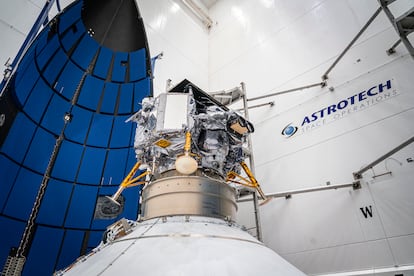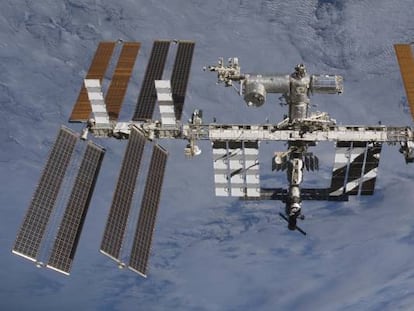US loses control of Peregrine 1, the private module with which it intended to re-land on the Moon
A private company on Monday launched the Vulcan rocket from Cape Canaveral but reported seven hours later that ‘an anomaly’ occurred

The Peregrine 1 module was already flying towards the Moon, in a mission that aims to be the first private initiative to achieve a soft landing on the lunar surface, when “an anomaly occurred.” Seven hours after a successful launch from Cape Canaveral aboard the Vulcan Centaur rocket, the company in charge of the lunar module, Astrobotic, announced that it had been unable to orient it towards the Sun to feed on its energy. In a later communiqué, the company explained that the problem may have arisen from poor propulsion of the module, which “if proven true, threatens the ability of the spacecraft to soft land on the Moon.” Three tense hours later, the company’s technicians managed to retake the reins of the device and restored communications with the probe to reorient it towards the Sun. But the propulsion failure that caused the initial anomaly resulted in “a critical loss of propellant.” Everything indicates that the module will be lost.
“The team is working to try and stabilize this loss, but given the situation, we have prioritized maximizing the science and data we can capture. We are currently assessing what alternative mission profiles may be feasible at this time,” Astrobotic said.
This is the first attempt at a private robotic flight to the moon in NASA’s Commercial Lunar Payload Services (CLPS) initiative, which is part of the plan to return to the moon within the Artemis program, in which the United States, Europe, Japan, and other countries are collaborating. Until this setback, all the preliminary steps of the plan to establish lunar colonies by the end of this decade and prepare for the jump to Mars in 20 years had been completed.
Almost six decades after the Soviet Union managed a soft moon landing on February 3, 1966, with its Luna 9 probe, placing a device on our satellite still remains a high-risk undertaking. India, which managed it with its Vikram module last year, becoming the fourth country to do so, had failed in a previous attempt in 2019. That same year, the Israeli company SpaceIL’s spacecraft crashed, ending the company’s attempts to be the first private project to achieve a Moon landing, a milestone that the Japanese firm Ispace did not reach in 2023 either. Against this background, the Vulcan rocket carrying the Peregrine robotic landing module was launched on Monday from Cape Canaveral in Florida as part of NASA’s CLPS (Commercial Lunar Payload Services) program, in what represents the first commercial robotic launch to the moon’s surface.
“They’re scouts going to the Moon ahead of us,” said NASA Administrator Bill Nelson. If it lands successfully, it will be the first time that the United States has landed on the Moon since 1972.
LIFTOFF of the first United Launch Alliance #VulcanRocket! pic.twitter.com/wZMlPxWr4l
— ULA (@ulalaunch) January 8, 2024
The Peregrine lander, which is about six feet tall (1.9 meters) and has a payload mass capacity of 200 lb (90 kg) is being carried inside a new rocket, the Vulcan Centaur, built by the company United Launch Alliance, a joint venture between Boeing and Lockheed Martin. It is the rocket’s first mission and also the inaugural flight for the engines made by Blue Origin, owned by Amazon chief Jeff Bezos, circumstances that add uncertainty to a mission with many pioneering features. If everything goes well, the trip to the Moon will last about 12 days and the probe will land in the Sinus Viscositatis (Bay of Stickiness) region, a territory over which lava flowed millions of years ago.
The mission is carrying 20 payloads, including NASA instruments. The U.S. space agency, which turned to this private initiative in 2019, wants to take measurements of the lunar atmosphere, the composition of the regolith (loose deposits over solid rock) and the radioactive environment that astronauts will face. Along with these tools, there are objects from seven countries. There is additional scientific material, such as a radiation detector from the German Aerospace Center, but also more symbolic things, such as a time capsule with messages from 80,000 children from around the world, and DNA samples and ashes from 70 humans sent by the American space burial company Elysium Space. These samples include those of the creator of Star Trek, Gene Roddenberry, the science fiction writer Arthur C. Clarke, and three presidents of the United States: George Washington, Dwight D. Eisenhower and John F. Kennedy.

Above all, the mission will be the first step in a new mode of lunar travel that could make the satellite more accessible to scientists and which may be a more efficient way for NASA to begin lunar colonization. Regardless of success or failure, this mission will be the first of 10 CLPS scheduled in the near future and John Thornton, CEO of Astrobiotic, has already warned that a setback will not stop them. It is estimated that the budget for the Astrobiotic mission is around $100 million, less than half as much as the movie Avatar cost.
The last time U.S. astronauts were on the surface of the moon was in 1972. Another private company, the Houston-based Intuitive Machines, aims to launch a lander in mid-February, flying on a SpaceX rocket. But first Japan will attempt to land on the Moon on January 19. The Japanese Space Agency’s lander, which has two small rovers, was launched in September along with a space telescope. If successful, Japan will become the fifth country to make a soft landing on the moon, after the Soviet Union, the United States, India, and China, which has landed three times in the last decade and plans to collect samples again at the end of this year.
Sign up for our weekly newsletter to get more English-language news coverage from EL PAÍS USA Edition









































